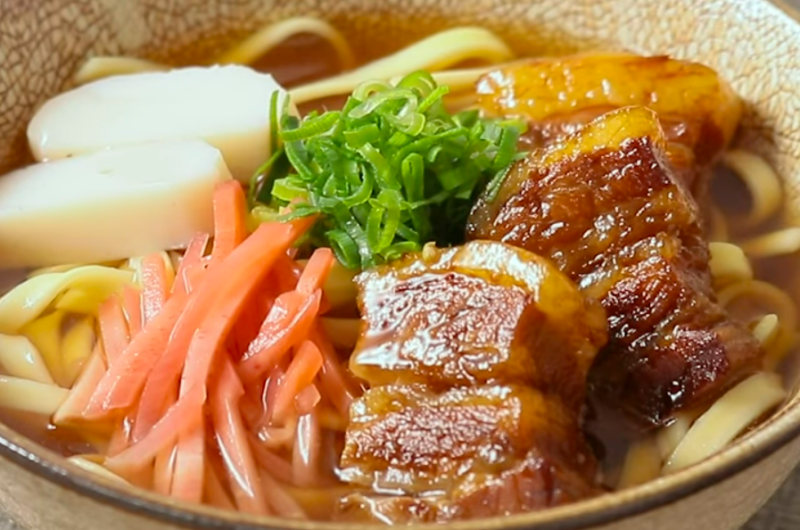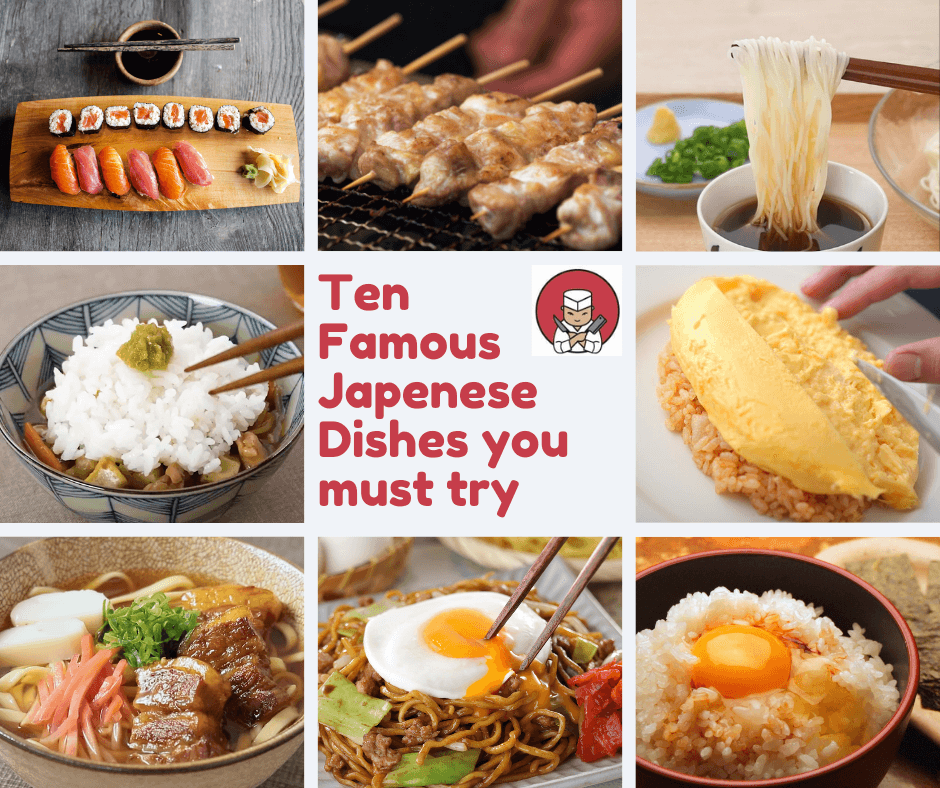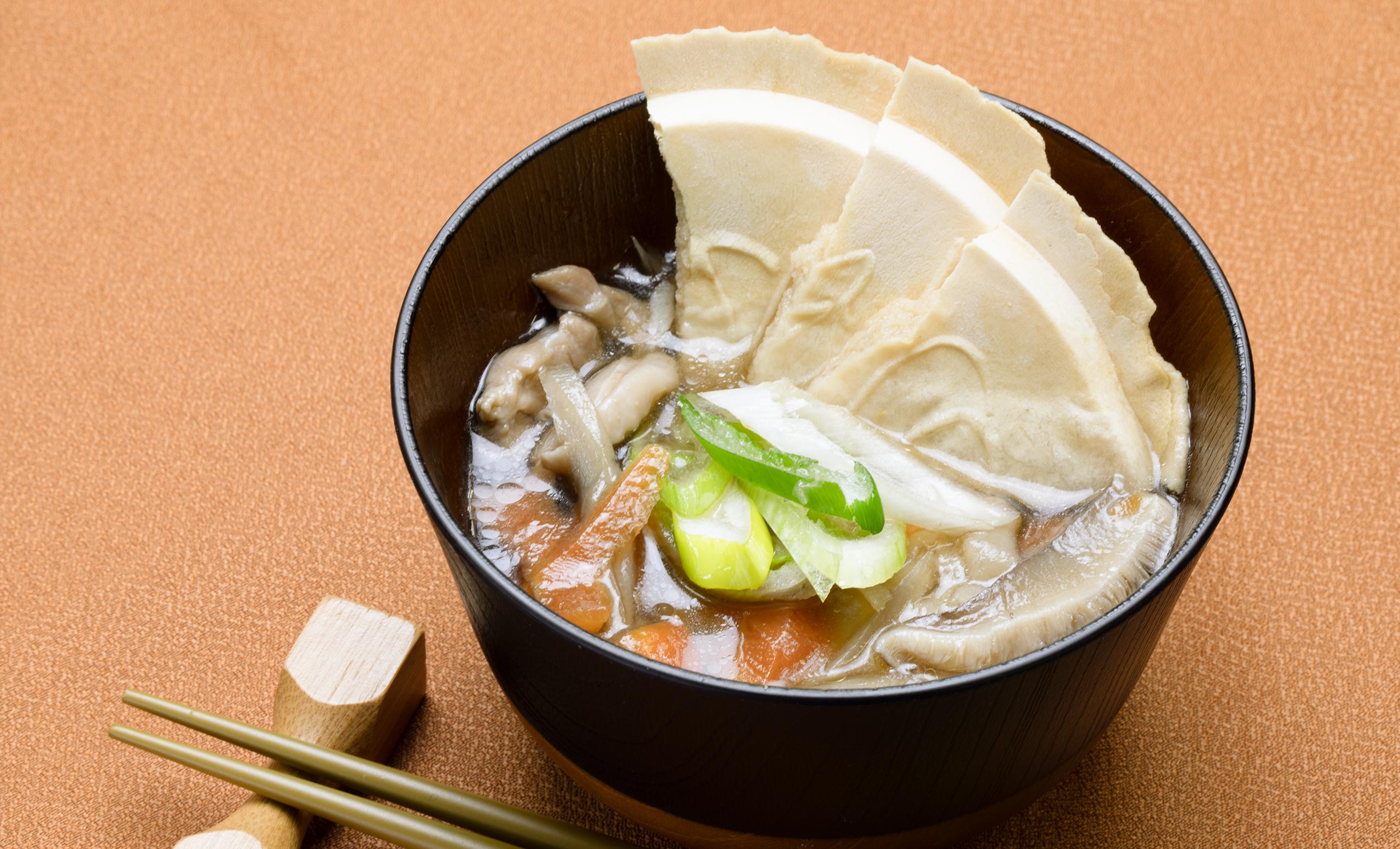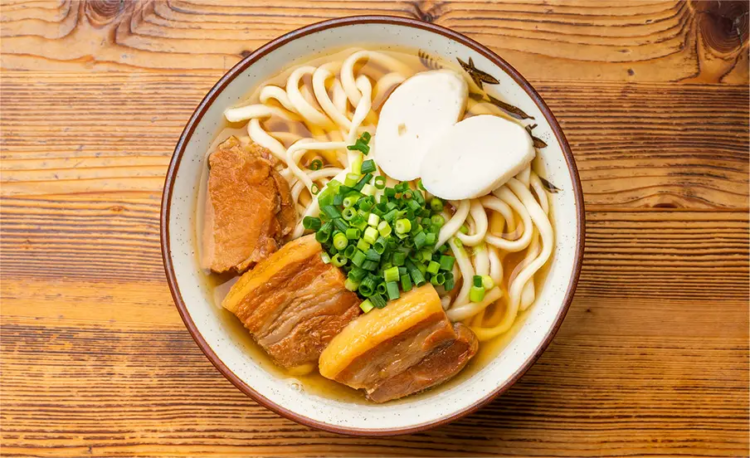
Okinawa soba (沖縄そば) is a signature noodle soup dish found throughout Okinawa Prefecture.
It features thick and chewy ramen noodles in a bonito based broth, topped with stewed pork (belly or ribs), and other garnishes.
Despite the name “soba“, the noodles are not made of buckwheat flour, but wheat flour. The noodles used are typically ramen noodles, called “Chinese Noodles” or “chuuka-men” (中華麺) in Japanese.
Read on for more interesting info about Okinawa soba:
Disclaimer: The Chef Dojo may receive a small commission if you decide to purchase products links on this page. It helps to support the website. Thanks!
Ingredients
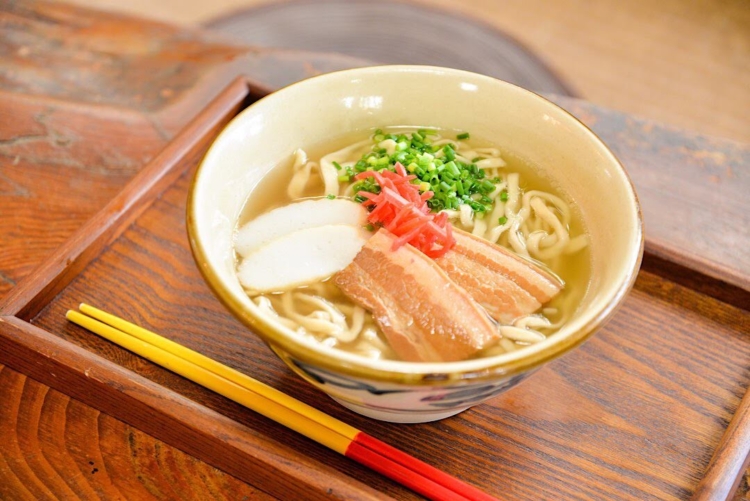
The main ingredients of Okinawa soba are:
- Noodles
- Pork
- Kamaboko
As mentioned earlier, the noodles used are a type of ramen noodle, or “Chinese noodles” (i.e. chuuka-men 中華麺), which are made of wheat flour, salt, water, and “kansui” (an special alkaline solution).
The noodles can be different thickness and curlyness/wavyness depending on the restaurant or region.
“Three-layer” pork belly (i.e. sanmaiku 三枚く) is the most typical cut of meat used. Another popular meat choice is pork ribs. If ribs are used, the dish is often referred to as “Soki soba” (ソーキそば). Soki means spare ribs in Okinawan dialect.
Another ingredient typically added is a type of fish cake, called Kamaboko in Japanese. Green onions and pickled red ginger (i.e. benishoga) are typical garnishes.
At restaurants, a special Okinawa chili oil called koregusu (コーレーグース) is provided for those who want an extra kick.
Location / Where to Eat
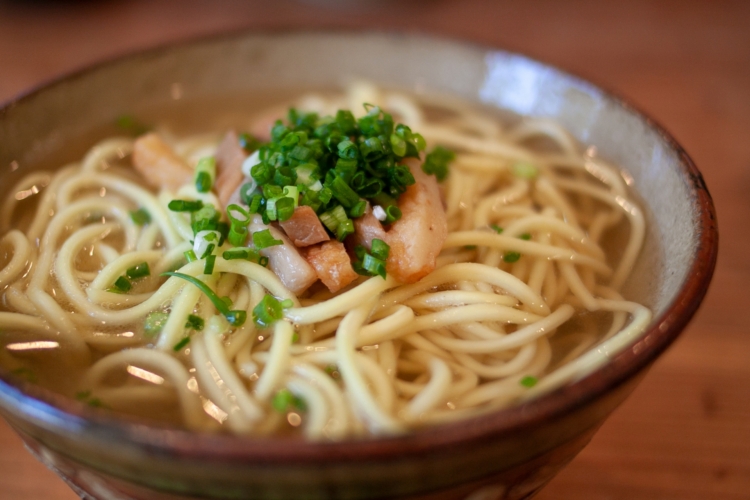
Okinawa soba is found all around Okinawa Prefecture.
It is an extremely common dish on the island. There are thousands of restaurants, big and small, that serve the beloved noodle dish.
Each area and restaurant has their own variation — size/width of noodles, cut of pork, broth flavor, etc. For example, the noodles are typically flat in the northern part of the main island of Okinawa, curly/thick in the southern part, and thin in the Yaeyama Islands (Ishigaki, etc.).
Different regions may also name their variation of Okinawa soba after the area — i.e. Yaeyama soba, Miyako soba, Nago soba, Shuri soba, Naha soba, Yonabaru soba, Kumejima soba, and Daito soba.
List of Okinawa Soba restaurants
Check out this site for a huge list of Okinawa soba restaurants to try in Okinawa — Suba.okinawa (in Japanese).
Outside of Okinawa, it is actually a bit rare to come across Okinawa soba unless you visit an Okinawa specialty restaurant.
History / Origin of Okinawa soba
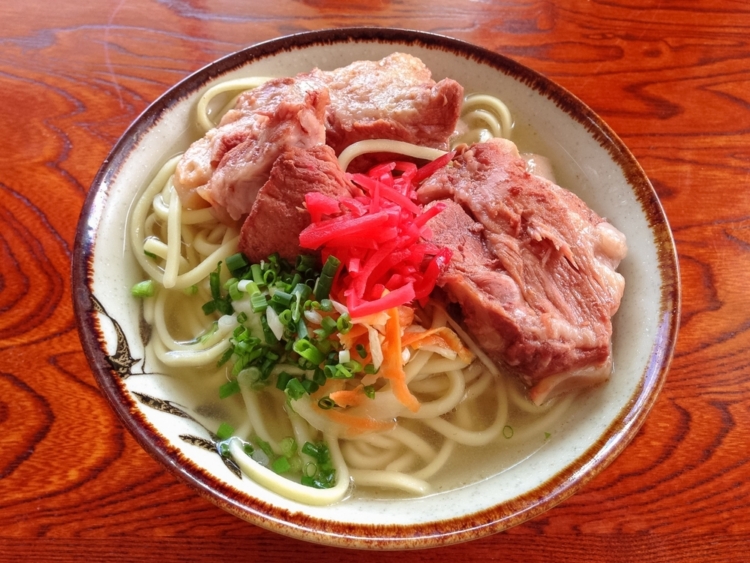
The original Okinawa soba is said to have been brought to the island from China around 500 years ago.
At that time, Okinawa was actually a separate country from Japan, and known as the “Ryukyu Kingdom“. The dish was only eaten by royalty, and other rich aristocrats.
It wasn’t until the late Meiji period (around 1900), that the modern version Okinawa soba began to form. It was around this time when Chinese people opened the first noodle restaurants in Okinawa available for common folk.
This original version of Okinawa soba was actually called “suba” すば at the time. Unfortunately most of the original restaurants/businesses were destroyed during the WW2.
After the war, the Americans provided an abundance of flour, and restaurants began opening again. The new restaurants began adapting the original version of Okinawa soba — which more resembled a typical Chinese noodle dish — to better suit local Okinawan tastes and ingredients.
Interestingly, many of the Okinawa soba restaurants were opened by women, who needed to make money after losing their husbands in the war.
How to make Okinawa Soba
It is not technically too difficult to make Okinawa soba from scratch, as the ingredients are quite straightforward. It does take a long time though, mainly because you need to stew the meat slowly.
Most of the ingredients (or similar ingredients) can also be purchased online, or at your local Japanese/Asian supermarket. Of course, if you want “authentic” Okinawan ingredients, you will probably need to go to Okinawa, or somewhere else in Japan.
Check out the step-by-step recipe below to make your very own Okinawa soba. Original recipe adapted from kurashiru.
Okinawa soba (沖縄そば): Okinawa’s Famous Noodle Soup
Course: MainCuisine: Japanese, OkinawaDifficulty: Medium1
servings15
minutes1
hour15
minutes300
kcalMake your own Okinawa soba from scratch!
Ingredients
- Equipment
Pot
Knife and Cutting board
Chopsticks
- Noodle Ingredients
Raw Ramen noodles / Okinawa soba noodles … 1 serving
Hot water (for boiling) … Appropriate amount
- Stewed Pork
Pork belly … 100g
Cooking sake or Awamori … 150ml
Soy sauce … 1 tablespoon
Brown sugar … 10g
Ginger 10g
- Soup Ingredients
Water … 400ml
Cooking sake … 1 tablespoon
Soy sauce … 1 teaspoon
Dashi granules / Instant dashi powder … 1 teaspoon
Chicken stock soup base … 1/2 teaspoon
- Toppings
Kamaboko … 20g
Benishoga (red ginger) … 10g
Green onion (cut into small pieces) … Appropriate amount
Koregusu (Okinawan chili oil) … 1/2 teaspoon
Directions
- Prep
- Cut the kamaboko into thick slices.
- Slice the ginger into thin slices, leaving the skin on.
- Rafute / Stewed Pork
- Make the Okinawan stewed pork (called “Rafute” in Japanese). Put the pork belly in a pot, and pour enough water so that it is completely submerged. Heat over medium heat, and bring the water to a boil. Once the water is boiling, change the heat to low, and continue boiling for about an hour.
- After an hour, drain the water and rinse the meat under running water.
- Once cooled down, cut the pork belly into approximately 3cm wide pieces.
- Put the sliced pork belly back into the pot with sliced ginger, cooking sake, soy sauce, and brown sugar. Bring to a boil over medium heat, then cover and simmer for about 15 minutes until the liquid has evaporated. Remove from the heat.
- Noodles + Finish
- Boil water in a pot, add noodles and boil according to package instructions. After the noodles are cooked, drain well using a colander.
- Add the soup ingredients to a pot, heat over medium heat, bring to a boil, then remove from heat.
- Add cooked noodles to a bowl. Pour the soup on. Layer the stewed pork, sliced kamaboko, and other garnishes on top. Enjoy!
Recipe Video
Notes
- The pork belly is traditionally cooked in Aawomori, a type of Okinawan liquor.
Fun Facts
- October 17th is the official “Okinawa Soba Day.”
- At first, Japan’s FTC did not allow Okinawa soba to be labelled as “soba” because it did not include 30% buckwheat flour. After 2 years of negotiation, the name was finally approved!
Summary
Have you ever tried Okinawa soba before? What did you think of it?
Leave your thoughts and comments below!
Subscribe for free today! Receive cool recipes, my latest Japanese knife picks and learn about Japanese culture. Delivered every other week to your inbox.
